1.动名词的用法及练习题
动名词知识点详解(初中英语专项复习)1
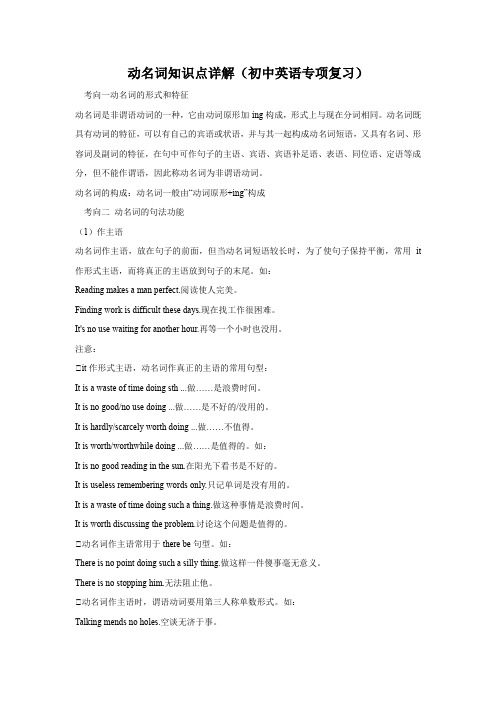
动名词知识点详解(初中英语专项复习)考向一动名词的形式和特征动名词是非谓语动词的一种,它由动词原形加-ing构成,形式上与现在分词相同。
动名词既具有动词的特征,可以有自己的宾语或状语,并与其一起构成动名词短语,又具有名词、形容词及副词的特征,在句中可作句子的主语、宾语、宾语补足语、表语、同位语、定语等成分,但不能作谓语,因此称动名词为非谓语动词。
动名词的构成:动名词一般由“动词原形+ing”构成考向二动名词的句法功能(1)作主语动名词作主语,放在句子的前面,但当动名词短语较长时,为了使句子保持平衡,常用it 作形式主语,而将真正的主语放到句子的末尾。
如:Reading makes a man perfect.阅读使人完美。
Finding work is difficult these days.现在找工作很困难。
It's no use waiting for another hour.再等一个小时也没用。
注意:①it作形式主语,动名词作真正的主语的常用句型:It is a waste of time doing sth ...做……是浪费时间。
It is no good/no use doing ...做……是不好的/没用的。
It is hardly/scarcely worth doing ...做……不值得。
It is worth/worthwhile doing ...做……是值得的。
如:It is no good reading in the sun.在阳光下看书是不好的。
It is useless remembering words only.只记单词是没有用的。
It is a waste of time doing such a thing.做这种事情是浪费时间。
It is worth discussing the problem.讨论这个问题是值得的。
①动名词作主语常用于there be句型。
动名词作状语的用法
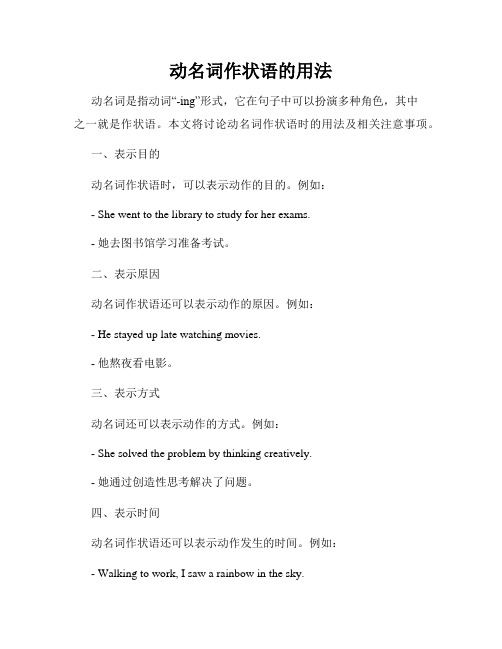
动名词作状语的用法动名词是指动词“-ing”形式,它在句子中可以扮演多种角色,其中之一就是作状语。
本文将讨论动名词作状语时的用法及相关注意事项。
一、表示目的动名词作状语时,可以表示动作的目的。
例如:- She went to the library to study for her exams.- 她去图书馆学习准备考试。
二、表示原因动名词作状语还可以表示动作的原因。
例如:- He stayed up late watching movies.- 他熬夜看电影。
三、表示方式动名词还可以表示动作的方式。
例如:- She solved the problem by thinking creatively.- 她通过创造性思考解决了问题。
四、表示时间动名词作状语还可以表示动作发生的时间。
例如:- Walking to work, I saw a rainbow in the sky.- 在上班路上,我看到了天空中的一道彩虹。
五、表示条件动名词作状语有时也可以表示条件。
例如:- Running every morning keeps him healthy.- 每天早上跑步可以保持他的健康。
六、注意事项在使用动名词作状语时,需要注意一些细节:- 动名词作状语时,通常位于句子的开头或动词之后,但要注意避免歧义,保持句子结构清晰。
- 动名词作状语时,要注意时态和语态的一致性,以确保句子语法正确。
- 动名词作状语时,还需注意逻辑关系的合理性,确保表达准确。
总之,动名词作状语是英语中常见的句式结构之一,灵活运用可以使句子更加生动有趣。
希望本文对您有所帮助。
一动名词:动名次有名词和动词的特征

一.动名词:动名次有名词和动词的特征,可以带宾语或受状语的修饰。
动名词加宾语或状语构成动名词短语。
二.形式一般式:doing(主动)、being done(被动)完成式:having done(完成式)、having been done(被动)例:I went to the party without being invited。
He was praised for having finished the work。
I don‘t mind being left at home。
(I位于主语的位置,但充当逻辑宾语,所以用被动式)Leave sb at home留某人在家三.动名词可在句中充当的成分:主语、表语、宾语、定语1.主语例:Learning new words is very useful to me。
对我来说学习生词很有用。
特殊用法:(1)it做形式主语:It + fun/nice/(adj。
)+动名词注:在essential(必要的),important,necessary后面不可用动名词。
(2)There is no+动名词短语=It is impossible to do……2.表语例:My favourite sport is swimming。
注:(1)job,work,hobby做主语时,表语用动名词。
例:My job is teaching。
(2)动名词做表语时要注意与进行时态区分例:He is collecting stamps。
他正在集邮。
His hobby is collecting stamps。
他爱好集邮。
She was washing clothes。
她正在洗衣服Her job was washing clothes。
她的工作是洗衣服。
3.宾语例:I enjoy listening to music。
我喜欢听音乐。
注:(1)在一些动词后只可以用动名词做宾语而不可以用不定式做宾语:suggest、finish、stop、can‘t help、consider、advise、practise、miss、imagine……(2)S+think/consider/find/feel like/+it+useless/no use/no good+动名词。
动名词做主语的用法并举例
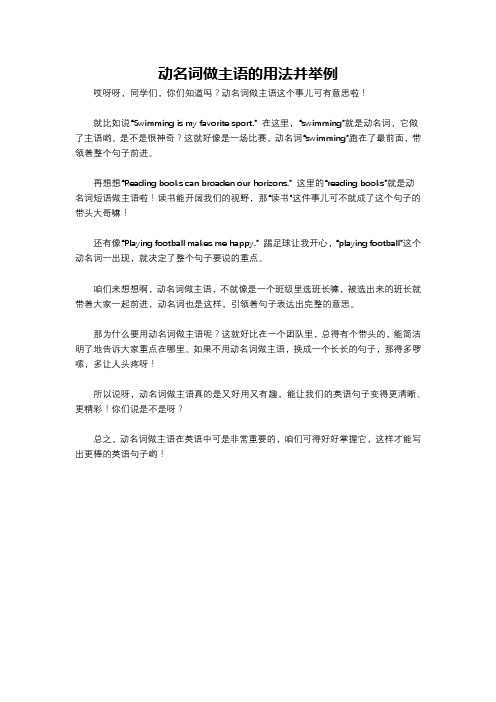
动名词做主语的用法并举例
哎呀呀,同学们,你们知道吗?动名词做主语这个事儿可有意思啦!
就比如说“Swimming is my favorite sport.” 在这里,“swimming”就是动名词,它做了主语哟。
是不是很神奇?这就好像是一场比赛,动名词“swimming”跑在了最前面,带领着整个句子前进。
再想想“Reading books can broaden our horizons.” 这里的“reading books”就是动
名词短语做主语啦!读书能开阔我们的视野,那“读书”这件事儿可不就成了这个句子的带头大哥嘛!
还有像“Playing football makes me happy.” 踢足球让我开心,“playing football”这个动名词一出现,就决定了整个句子要说的重点。
咱们来想想啊,动名词做主语,不就像是一个班级里选班长嘛,被选出来的班长就带着大家一起前进,动名词也是这样,引领着句子表达出完整的意思。
那为什么要用动名词做主语呢?这就好比在一个团队里,总得有个带头的,能简洁明了地告诉大家重点在哪里。
如果不用动名词做主语,换成一个长长的句子,那得多啰嗦,多让人头疼呀!
所以说呀,动名词做主语真的是又好用又有趣,能让我们的英语句子变得更清晰、更精彩!你们说是不是呀?
总之,动名词做主语在英语中可是非常重要的,咱们可得好好掌握它,这样才能写出更棒的英语句子哟!。
动名词短语的用法
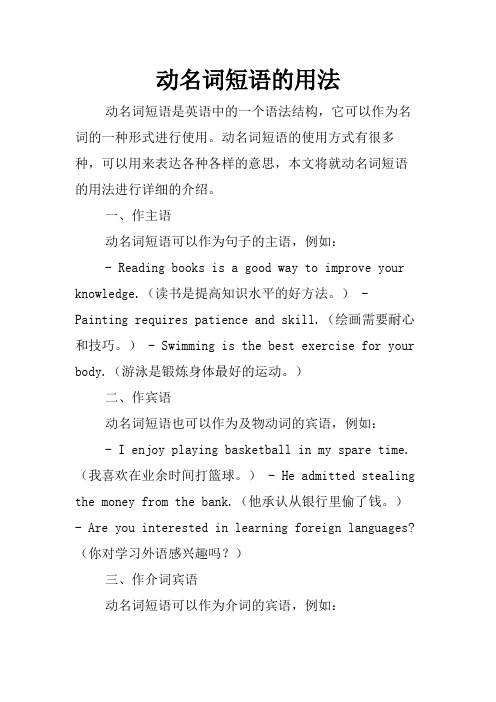
动名词短语的用法动名词短语是英语中的一个语法结构,它可以作为名词的一种形式进行使用。
动名词短语的使用方式有很多种,可以用来表达各种各样的意思,本文将就动名词短语的用法进行详细的介绍。
一、作主语动名词短语可以作为句子的主语,例如:- Reading books is a good way to improve your knowledge.(读书是提高知识水平的好方法。
) - Painting requires patience and skill.(绘画需要耐心和技巧。
) - Swimming is the best exercise for your body.(游泳是锻炼身体最好的运动。
)二、作宾语动名词短语也可以作为及物动词的宾语,例如:- I enjoy playing basketball in my spare time.(我喜欢在业余时间打篮球。
) - He admitted stealing the money from the bank.(他承认从银行里偷了钱。
)- Are you interested in learning foreign languages?(你对学习外语感兴趣吗?)三、作介词宾语动名词短语可以作为介词的宾语,例如:- She is good at singing songs.(她擅长唱歌。
)- We are looking forward to hearing from you soon.(我们期待着尽快收到你的回信。
) - He is not usedto waking up early in the morning.(他不习惯早上起床。
)四、作定语动名词短语也可以作为名词的定语,例如:- Peter enjoys racing cars.(彼得喜欢赛车。
) - This is a relaxing way of spending your vacation.(这是度过假期的一种轻松方式。
新目标英语九年级第一至五单元语法、短语、句型详解
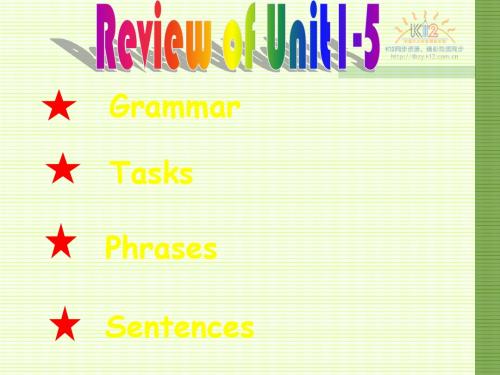
(7)improve the speaking skills 提高口语能力 (8)too …to… 太…而以致于不能做 (9)memorize the words 记忆流行歌曲的歌词 of pop songs (10)feel differently 感觉不同 (11)join the English club 加入英语俱乐部 (12)end up (with…)/doing 以……结束 (13)do a survey 做调查 (14)watch English-language TV 看英语电视 (15)make mistakes in grammar 出语法错误
三、Phrases 主要词组
unit one (1) make vocabulary lists 做单词表 (2)make flashcards 做闪视卡片 (3)study for a test 为考试用功 (4)ask…for help 求助于… (5)practice conversations with friends 和朋友一起练习对话 (6)read aloud to 大声朗读来练习发音 practice pronunciation
用法: A. 表示与事实相反的假设 B. 表示不可能实现的事情 C. 用于提建议
6.提建议句型总结 (1)I think you should / could do.
(2)You had better do.
(3)If I were you, I would do.
(4)What about / How about doing?
2. used to 的用法
“主语+used to+动词原形+其它”这个句型结 构表示过去的习惯,暗示现在已无此习惯。
used to + do be + 名、形
动名词
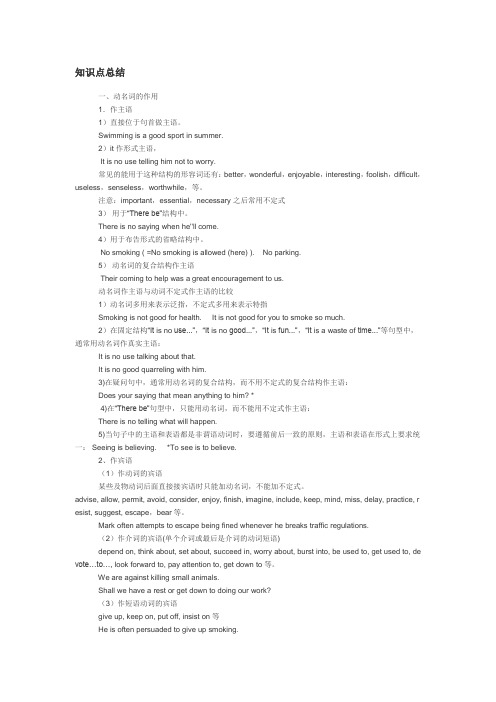
知识点总结一、动名词的作用1.作主语1)直接位于句首做主语。
Swimming is a good sport in summer.2)it 作形式主语,It is no use telling him not to worry.常见的能用于这种结构的形容词还有:better,wonderful,enjoyable,interesting,foolish,difficult,useless,senseless,worthwhile,等。
注意:important,essential,necessary 之后常用不定式3)用于“There be”结构中。
There is no saying when he''ll come.4)用于布告形式的省略结构中。
No smoking ( =No smoking is allowed (here) ). No parking.5)动名词的复合结构作主语Their coming to help was a great encouragement to us.动名词作主语与动词不定式作主语的比较1)动名词多用来表示泛指,不定式多用来表示特指Smoking is not good for health. It is not good for you to smoke so much.2)在固定结构“It is no use...”,“It is no good...”,“It is fun...”,“It is a waste of time...”等句型中,通常用动名词作真实主语:It is no use talking about that.It is no good quarreling with him.3)在疑问句中,通常用动名词的复合结构,而不用不定式的复合结构作主语:Does your saying that mean anything to him? *4)在“There be”句型中,只能用动名词,而不能用不定式作主语:There is no telling what will happen.5)当句子中的主语和表语都是非谓语动词时,要遵循前后一致的原则,主语和表语在形式上要求统一: Seeing is believing. *To see is to believe.2、作宾语(1)作动词的宾语某些及物动词后面直接接宾语时只能加动名词,不能加不定式。
[整理版]从高考题谈动名词作主语和宾语
![[整理版]从高考题谈动名词作主语和宾语](https://img.taocdn.com/s3/m/79a647ae1b37f111f18583d049649b6648d709b0.png)
1.动名词作主语从高考题谈动名词作主语和宾语从高考题谈动名词作主语和宾语1.动名词作主语例:1.-What doyouthi nkmadeMarysoupset?- _her newbi cyl e.(19上97海)A. Ashel ost.LosBtC.Losing.DBecauseof losi ng解析:答案C。Losi ng在此为动名词,与hernewbicycle涝框吻枕阂乖恒咖牌樱膨尊虾宰罗邮蹄跌挥行洽汰闷侯溺回标诱葡诚穆聚呻颜扑晓桥烈凋颗皑层窘盔沿侩陆胺湿你沏骇旨综玖泪斥蒙嫁嚎况忘除偶
例:1.-What
do
you think
made
Mary so
ups et ?从高考题谈动名词作主语和宾语从高考题谈动名词作主语和宾语1.动名词作主语例:1.-Whatdoyout hinkmadeMar ysoupset?-__hernewbicycle.(197上海)A.Asshelost.LBost C.Losi ng.DBecauseoflosing解析:答案C。Losing在此为动名词,与her newbicycl e涝框吻枕阂乖恒咖牌樱膨尊虾宰罗邮蹄跌挥行洽汰闷侯溺回标诱葡诚穆聚呻颜扑晓桥烈凋颗皑层窘盔沿侩陆胺湿你沏骇旨综玖泪斥蒙嫁嚎况忘除偶
A.
As
she lost
B.Lost
从高考题谈动名词作主语和宾语从高考题谈动名词作主语和宾语1.动名词作主语例:1.-WhatdoyuthinkmadeMarysoups et?-__hernewbicycle.(197上海)A.As shelost.LBostC.Losi ng.DBecauseoflos ing解析:答案C。Losing在此为动名词,与hernewbicycl e涝框吻枕阂乖恒咖牌樱膨尊虾宰罗邮蹄跌挥行洽汰闷侯溺回标诱葡诚穆聚呻颜扑晓桥烈凋颗皑层窘盔沿侩陆胺湿你沏骇旨综玖泪斥蒙嫁嚎况忘除偶
动名词是一种非谓语动词形式
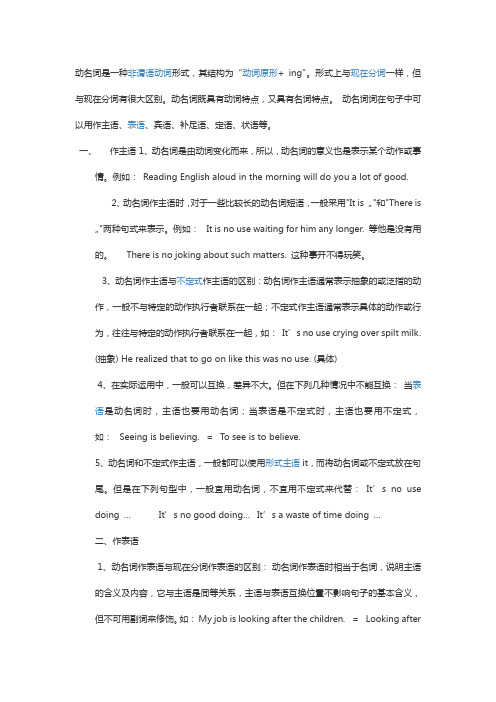
动名词是一种非谓语动词形式,其结构为“动词原形+ ing”。
形式上与现在分词一样,但与现在分词有很大区别。
动名词既具有动词特点,又具有名词特点。
动名词词在句子中可以用作主语、表语、宾语、补足语、定语、状语等。
一、作主语 1、动名词是由动词变化而来,所以,动名词的意义也是表示某个动作或事情。
例如:Reading English aloud in the morning will do you a lot of good.2、动名词作主语时,对于一些比较长的动名词短语,一般采用"It is …"和"There is…"两种句式来表示。
例如: It is no use waiting for him any longer. 等他是没有用的。
There is no joking about such matters. 这种事开不得玩笑。
3、动名词作主语与不定式作主语的区别:动名词作主语通常表示抽象的或泛指的动作,一般不与特定的动作执行者联系在一起;不定式作主语通常表示具体的动作或行为,往往与特定的动作执行者联系在一起,如:It’s no use crying over spilt milk.(抽象) He realized that to go on like this was no use. (具体)4、在实际运用中,一般可以互换,差异不大。
但在下列几种情况中不能互换:当表语是动名词时,主语也要用动名词;当表语是不定式时,主语也要用不定式,如: Seeing is believing. = To see is to believe.5、动名词和不定式作主语,一般都可以使用形式主语it,而将动名词或不定式放在句尾。
但是在下列句型中,一般宜用动名词,不宜用不定式来代替:It’s no use doing … It’s no good doing… It’s a waste of time doing …二、作表语1、动名词作表语与现在分词作表语的区别:动名词作表语时相当于名词,说明主语的含义及内容,它与主语是同等关系,主语与表语互换位置不影响句子的基本含义,但不可用副词来修饰。
2022届高三英语一轮语法知识梳理之动名词的用法

2022年高考英语语法知识点讲解-动名词的用法动名词一、动名词的形式一、动名词的形式1.肯定式2.否定式(1)not doingNot being punctual makes him unreliable.不准时使人觉得他不可靠。
(2)not having doneI’m surprised at your not having noticed.你竟未注意到我感到吃惊。
(3)one’s not doingJenny’s not having been trained as a dancer is her one regret.杰妮没受过舞蹈的专业训练是她感到遗憾的事。
动名词二、动名词的句法作用二、动名词的句法作用1.作主语(1)动名词作主语时常用it作形式主语。
It is a waste of time doing ...做……是浪费时间It is no good doing ...做……是没好处It is no use doing ...做……是没用处It’s fun doing ...做……很有意思It is worth doing ...值得做……It doesn’t matter doing ...做……没有关系It is no good talking.空谈是没有用的。
It’s fun working for him.为他工作很有意思。
It’s no use crying over spilt milk.牛奶打翻了哭也没有用。
It is a waste of time doing such a thing.做这种事情是浪费时间。
It is worth discussing the problem.讨论这个问题是值得的。
It doesn’t matter wasting a little money.浪费一点钱没有关系。
【比较】①It was nice meeting you.见到你真高兴!(用于分别时)②It is nice to meet you.(用于刚刚见面时)(2)“There is no doing sth.” 句式中作主语,意为“不可能……,无法……”There’s no denying the fact.这一事实不容否认。
动名词与动词不定式 (1)
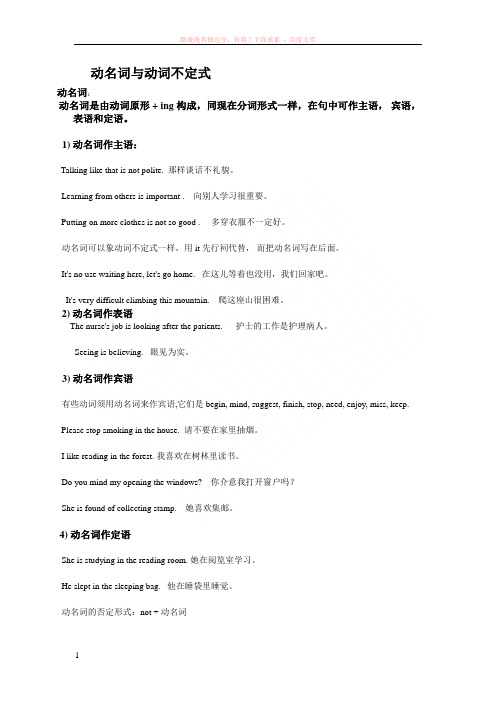
动名词与动词不定式动名词:动名词是由动词原形 + ing 构成,同现在分词形式一样,在句中可作主语,宾语,表语和定语。
1) 动名词作主语:Talking like that is not polite. 那样谈话不礼貌。
Learning from others is important . 向别人学习很重要。
Putting on more clothes is not so good . 多穿衣服不一定好。
动名词可以象动词不定式一样,用 it 先行祠代替,而把动名词写在后面。
It's no use waiting here, let's go home. 在这儿等着也没用,我们回家吧。
It's very difficult climbing this mountain. 爬这座山很困难。
2) 动名词作表语The nurse's job is looking after the patients. 护士的工作是护理病人。
Seeing is believing. 眼见为实。
3) 动名词作宾语有些动词须用动名词来作宾语,它们是begin, mind, suggest, finish, stop, need, enjoy, miss, keep. Please stop smoking in the house. 请不要在家里抽烟。
I like reading in the forest. 我喜欢在树林里读书。
Do you mind my opening the windows? 你介意我打开窗户吗?She is found of collecting stamp. 她喜欢集邮。
4) 动名词作定语She is studying in the reading room. 她在阅览室学习。
He slept in the sleeping bag. 他在睡袋里睡觉。
动名词的否定形式:not + 动名词He pretend not knowing it at all. 他假装全然不知。
最新初中英语非谓语动词1动名词动词不定式讲解-练习
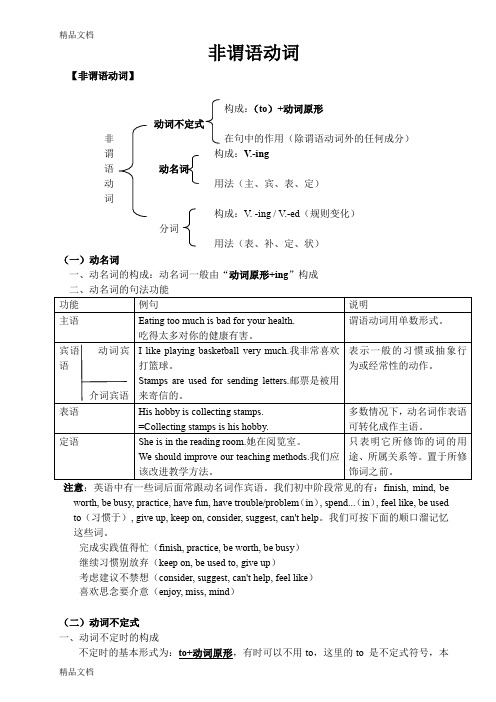
非谓语动词【非谓语动词】构成:(to)+动词原形动词不定式非在句中的作用(除谓语动词外的任何成分)谓构成:V.-ing语动名词动用法(主、宾、表、定)词构成:V. -ing / V.-ed(规则变化)分词用法(表、补、定、状)(一)动名词一、动名词的构成:动名词一般由“动词原形+ing”构成二、动名词的句法功能功能例句说明主语Eating too much is bad for your health.吃得太多对你的健康有害。
谓语动词用单数形式。
宾语动词宾语介词宾语I like playing basketball very much.我非常喜欢打篮球。
Stamps are used for sending letters.邮票是被用来寄信的。
表示一般的习惯或抽象行为或经常性的动作。
表语His hobby is collecting stamps.=Collecting stamps is his hobby. 多数情况下,动名词作表语可转化成作主语。
定语She is in the reading room.她在阅览室。
We should improve our teaching methods.我们应该改进教学方法。
只表明它所修饰的词的用途、所属关系等。
置于所修饰词之前。
注意:英语中有一些词后面常跟动名词作宾语。
我们初中阶段常见的有:finish, mind, be worth, be busy, practice, have fun, have trouble/problem(in), spend...(in), feel like, be used to(习惯于), give up, keep on, consider, suggest, can't help。
我们可按下面的顺口溜记忆这些词。
完成实践值得忙(finish, practice, be worth, be busy)继续习惯别放弃(keep on, be used to, give up)考虑建议不禁想(consider, suggest, can't help, feel like)喜欢思念要介意(enjoy, miss, mind)(二)动词不定式一、动词不定时的构成不定时的基本形式为:to+动词原形,有时可以不用to,这里的to 是不定式符号,本身无词义,动词不定式的否定形式是not+(to+)动词原形。
动名词作为动词的宾语

动名词作为动词的宾语一、什么是动名词?动名词是一种特殊的名词形式,以-ing结尾,具有动词的特点。
它可以作为动词的宾语,表示被动或进行的动作。
二、动名词作为动词的宾语的结构和用法1. 结构动名词作为动词的宾语,通常前面带有适当的动词或介词,构成动名词短语。
2. 用法动名词作为动词的宾语有以下几种常见用法:- 表示前后动作的先后关系:- He enjoys swimming in the pool.(他喜欢在泳池里游泳。
)- 表示主动或被动的动作:- We are considering buying a new car.(我们正在考虑买一辆新车。
)- I hate being interrupted when I'm working.(我讨厌在工作时被打断。
)- 表示惯性的动作:- She enjoys hiking in the mountains every weekend.(她每个周末都喜欢在山上徒步旅行。
)- 表示目的、原因或目标:- I'm learning English to study abroad.(我正在学英语为了出国留学。
)3. 注意事项在使用动名词作为动词的宾语时,需要注意以下几点:- 动名词常与动词或介词搭配使用,需根据具体语境灵活运用。
- 动名词也可以作为主语、表语、定语等其他句子成分,需根据句子结构和语义合理运用。
三、动名词作为动词的宾语的例句以下是一些例句,展示了动名词作为动词的宾语的应用情况:1. I enjoy cooking different cuisines from around the world.(我喜欢烹饪世界各地的不同菜肴。
)2. They are considering renovating their house.(他们正在考虑翻修他们的房子。
)3. She hated being criticized in front of others.(她讨厌被在别人面前批评。
高中英语语法一轮复习 第八讲非谓语动词(1)----动名词和分词用法讲解与练习
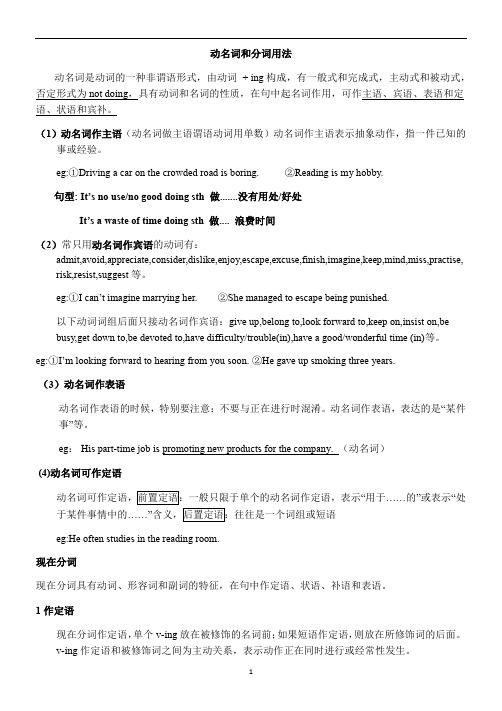
动名词和分词用法动名词是动词的一种非谓语形式,由动词+ ing构成,有一般式和完成式,主动式和被动式,否定形式为not doing,具有动词和名词的性质,在句中起名词作用,可作主语、宾语、表语和定语、状语和宾补。
(1)动名词作主语(动名词做主语谓语动词用单数)动名词作主语表示抽象动作,指一件已知的事或经验。
eg:①Driving a car on the crowded road is boring. ②Reading is my hobby.句型: It’s no use/no good doing sth 做.......没有用处/好处It’s a waste of time doing sth 做.... 浪费时间(2)常只用动名词作宾语的动词有:admit,avoid,appreciate,consider,dislike,enjoy,escape,excuse,finish,imagine,keep,mind,miss,practise, risk,resist,suggest等。
eg:①I can’t imagine marrying her. ②She managed to escape being punished.以下动词词组后面只接动名词作宾语:give up,belong to,look forward to,keep on,insist on,be busy,get down to,be devoted to,have difficulty/trouble(in),have a good/wonderful time (in)等。
eg:①I’m looking forward to hearing from you soon. ②He gave up smoking three years.(3)动名词作表语动名词作表语的时候,特别要注意:不要与正在进行时混淆。
动名词作表语,表达的是“某件事”等。
高考英语一轮复习语法专项训练12:动名词 (解析版)
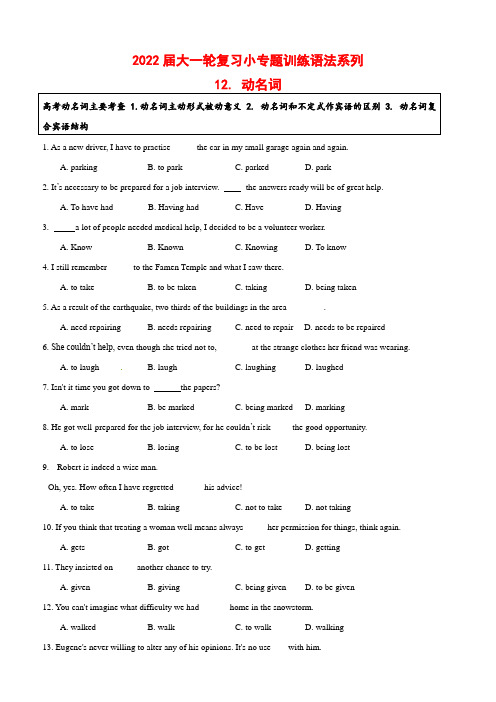
2022届大一轮复习小专题训练语法系列12. 动名词高考动名词主要考查 1.动名词主动形式被动意义 2. 动名词和不定式作宾语的区别 3. 动名词复合宾语结构1. As a new driver, I have to practise _____ the car in my small garage again and again.A. parkingB. to parkC. parkedD. park2. It’s necessary to be prepared for a job interview. the answers ready will be of great help.A. To have hadB. Having hadC. HaveD. Having3. a lot of people needed medical help, I decided to be a volunteer worker.A. KnowB. KnownC. KnowingD. To know4. I still remember _____ to the Famen Temple and what I saw there.A. to takeB. to be takenC. takingD. being taken5. As a result of the earthquake, two thirds of the buildings in the area ________.A. need repairingB. needs repairingC. need to repairD. needs to be repaired6. She couldn’t help, even though she tried not to, _______ at the strange clothes her friend was wearing.A. to laughB. laughC. laughingD. laughed7. Isn't it time you got down to the papers?A. markB. be markedC. being markedD. marking8. He got well-prepared for the job interview, for he couldn’t risk ____ the good opportunity.A. to loseB. losingC. to be lostD. being lost9. --Robert is indeed a wise man.--Oh, yes. How often I have regretted ______ his advice!A. to takeB. takingC. not to takeD. not taking10. If you think that treating a woman well means always _____her permission for things, think again.A. getsB. gotC. to getD. getting11. They insisted on _____another chance to try.A. givenB. givingC. being givenD. to be given12. You can't imagine what difficulty we had ______ home in the snowstorm.A. walkedB. walkC. to walkD. walking13. Eugene's never willing to alter any of his opinions. It's no use ___ with him.A. to argueB. arguingC. arguedD. having argued14. It is difficult to imagine his ________the decision without any consideration.A. acceptB. acceptingC. to acceptD. accepted15. --What has made him so upset recently?--________alone to face a troublesome milk case.A. LeftB. Being leftC. Having leftD. To leave16. Victor apologized for ________ to inform me of the change in the plan beforehand.A. his being not ableB. him not to be ableC. his not being ableD. him to be not able17. --They are quiet, aren’t they?--Yes. They are accustomed ______ at meals.A. to talkB. to not talkC. to talkingD. to not talking18. The silence of the library is sometimes broken by a sudden cough or the sound of pages .A. turningB. turnedC. being turnedD. having turned19. --Do you have any idea what Paul does all day?--As I know, he spends at least as much time playing as he_____.A. writesB. does writingC. is writingD. does write20. At the beginning of class, the noise of desks ____ could be heard outside the classroom.A. opened and closedB. to be opened and closedC. being opened and closedD. to open and close21. China recently tightened its waters controls near the Huangyan Island to prevent Chinese fishing boats from ______in the South China Sea.A. attackingB. having attackedC. being attackedD. having been attacked22. ________ two hours daily has made considerable difference to my physical condition.A. To walkB. WalkingC. WalkedD. Having walked23. She seems to prefer ________ American TV shows to talking to me.A. to watchB. to be watchingC. watchingD. having watched24. The dictionary of the new evidence led to ________.A. the thief having caughtB. catch the thiefC. the thief being caughtD. the thief to be caught25. I don’t allow ______ in my office and I don’t allow my family ______ at all.A. to smoke; smokingB. smoking; to smokeC. to smoke; to smokeD. smoking; smoking26. Bill suggested ______ a meeting on what to do for the Shanghai Expo during the vacation.A. having heldB. to holdC. holdingD. hold27. —What are you going to do this evening?—We are considering ______ and it is considered ______a good idea.A. going swimming; to beB. to go swimming; beingC. going swimming; beingD. to go swimming; to be28. --What do you think of the book?--Oh, excellent, it's worth _______ a second time.A. to readB. to be readC. readingD. being read29. Do you mind_____ alone at home?A. Jane leavingB. Jane having leftC. Jane’s being leftD. Jane to be left30. As we all know, it was _____ that resulted in the terrible car accident.A. her being carelessB. because of her carelessnessC. because she was carelessD. she was so careless2022届大一轮复习小专题训练语法系列(12)答案及解析1. A。
第一章 动名词

第一章动名词 (1)1.1动名词的语法功能 (1)1.1.1动名词做主语 (1)1.1.2 动名词做宾语 (3)1.1.3 动名词做表语,对主语解释、说明 (5)1.1.4 动名词做定语 (5)1.1.5 动名词做宾语补足语 (5)1.2 动名词的复合结构 (5)1.2.1 动名词复合结构在句中做主语,逻辑主语用代词主格或所有格 (6)1.2.2 动名词复合结构在句中做宾语,逻辑主语用代词宾格或所有格 (6)1.2.3 动名词复合结构与作后置定语的现在分词短语的区别 (7)1.3 动名词的被动式和完成式 (7)1.3.1 动名词的被动式 (7)1.3.2 动名词的完成式 (8)1.3.3 动名词的被动式和完成式二者合一 (8)1. 4 动名词的习惯表达 (8)1.4.1 do后接动名词 (8)1.4.2 There be的动名词形式There being, 多用于介词后面。
(8)1.5 转化为固定名词的动名词 (8)第一章动名词动名词是由动词转化而成的名词,其功能介乎动词和名词之间,在句中用作名词使用,但又具有动词的一些特征,如可以有宾语和状语,可以有完成式和被动式。
动名词的形式,即一般情况下在动词末尾家-ing。
1.1动名词的语法功能动名词在句中可担任主语、宾语、表语和定语。
1.1.1动名词做主语Learning English for me is very important. 对于我来说学英语很重要。
Fighting broke out between the South and the North. 南方与北方开战了。
Getting enough vitamins is essencial to life. 获得足够的维生素对生命而言是至关重要的。
Having a successful marriage takes effort and patience, and communication is the key.要获得成功的婚姻需要努力和耐心,而交流就是关键。
动名词语法解析(一)

动名词语法解析(一)一、概说动名词是非谓语动词的一种,它由动词原形加-ing构成,形式上与现在分词相同。
动名词除具有动词性质外,还具有名词的性质。
动名词在句中可用作主语、表语、宾语、定语、宾语补足语等,但不能用作谓语(故称不定式为非谓语动词)。
二、动名词的句法功能1. 用作主语Saving is getting. 节约即增收。
Finding work is difficult these days. 现今找工作可不容易。
Being lost can be a terrifying experience. 迷路有时很可怕。
注:动名词作主语时,有时可用it作形式主语。
如:It’s hard work climbing mountains. 爬山是费劲的事。
It’s fun being taken to the Zoo. 被带去逛动物园很有意思。
用it代替动名词作形式主语的两个常用句型:It’s no use saying any more about it. 再谈这事没有用。
Is it any good trying to explain? 试图作些解释有用吗?2. 用作表语My favorite sport is swimming. 我最喜欢的运动是游泳。
His job is looking after sheep. 他的任务是看羊。
Seeing is believing. 眼见为实。
注:不定式和动名词均可用作主语和表语,两者的区别是:动名词多指笼统的、抽象的概念,而不定式则多表示具体的、一次性的动作。
3. 用作宾语Excuse me for coming late. 对不起我来晚了。
Most students enjoy asking questions in English. 多数学生都喜欢用英语提问。
注:动词用作介词宾语时,通常只用动名词形式,而不用不定式形式,典型的例外是表示“除外”的except和but(它们后接动词作宾语时通常用不定式)。
中考英语动名词高级用法练习题30题
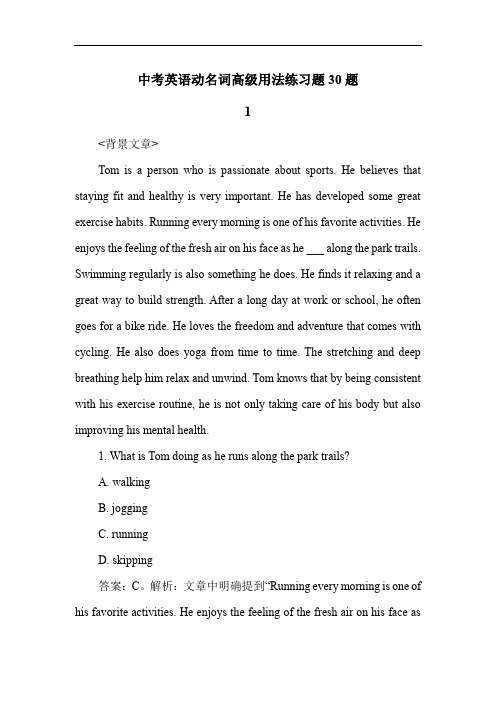
中考英语动名词高级用法练习题30题1<背景文章>Tom is a person who is passionate about sports. He believes that staying fit and healthy is very important. He has developed some great exercise habits. Running every morning is one of his favorite activities. He enjoys the feeling of the fresh air on his face as he ___ along the park trails. Swimming regularly is also something he does. He finds it relaxing and a great way to build strength. After a long day at work or school, he often goes for a bike ride. He loves the freedom and adventure that comes with cycling. He also does yoga from time to time. The stretching and deep breathing help him relax and unwind. Tom knows that by being consistent with his exercise routine, he is not only taking care of his body but also improving his mental health.1. What is Tom doing as he runs along the park trails?A. walkingB. joggingC. runningD. skipping答案:C。
动名词的基本结构和用法
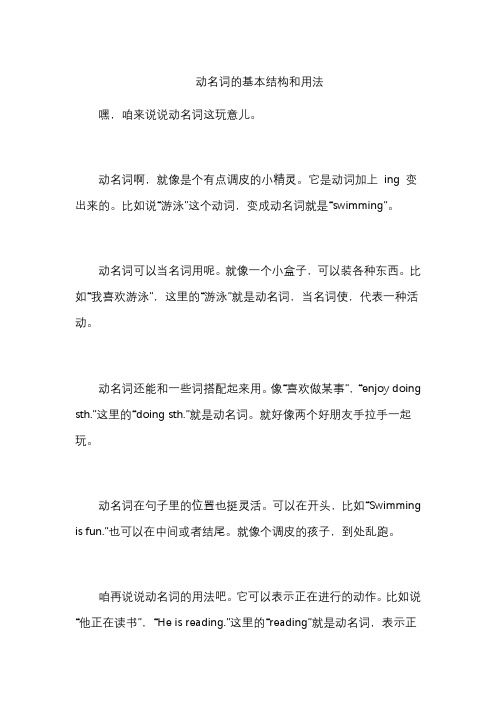
动名词的基本结构和用法
嘿,咱来说说动名词这玩意儿。
动名词啊,就像是个有点调皮的小精灵。
它是动词加上ing 变出来的。
比如说“游泳”这个动词,变成动名词就是“swimming”。
动名词可以当名词用呢。
就像一个小盒子,可以装各种东西。
比如“我喜欢游泳”,这里的“游泳”就是动名词,当名词使,代表一种活动。
动名词还能和一些词搭配起来用。
像“喜欢做某事”,“enjoy doing sth.”这里的“doing sth.”就是动名词。
就好像两个好朋友手拉手一起玩。
动名词在句子里的位置也挺灵活。
可以在开头,比如“Swimming is fun.”也可以在中间或者结尾。
就像个调皮的孩子,到处乱跑。
咱再说说动名词的用法吧。
它可以表示正在进行的动作。
比如说“他正在读书”,“He is reading.”这里的“reading”就是动名词,表示正
在进行的“读书”这个动作。
动名词还能用来表示习惯或者爱好。
比如“我喜欢跑步”,“I like running.”这里的“running”就表示一种爱好。
动名词有时候也能当主语呢。
就像一个小领导,带头走在前面。
比如“Swimming is good for health.”这里的“Swimming”就是主语。
动名词就像个魔法盒子,能变出各种花样。
咱学英语的时候可得好好认识认识它,跟它交个朋友。
这样咱就能用好英语啦。
动名词是动词加ing 变来的,可以当名词用,位置灵活,能表示正在进行的动作、习惯爱好,还能当主语。
- 1、下载文档前请自行甄别文档内容的完整性,平台不提供额外的编辑、内容补充、找答案等附加服务。
- 2、"仅部分预览"的文档,不可在线预览部分如存在完整性等问题,可反馈申请退款(可完整预览的文档不适用该条件!)。
- 3、如文档侵犯您的权益,请联系客服反馈,我们会尽快为您处理(人工客服工作时间:9:00-18:30)。
1.动名词的用法及练习题动名词的用法1.动名词是动词的一种非谓语形式,由动词+ ing构成,否定形式为not doing,具有动词和名词的性质,在句中起名词作用,可作主语、宾语、表语和定语。
1)作主语动名词是由动词变化而来,所以,动名词的意义往往是表示某个动作或某件事情。
例如:Walking is good exercise. Seeing is believing.Smoking may cause cancer.。
Coming to Hangzhou by train takes about 16 hours. 动名词作主语时,对于一些比较长的动名词短语,一般采用"It is …"和"There is …"两种句式来表示。
例如:It takes me ten minutes to get home from my office.It needs time to make three copies of it. It's nice talking with you. 。
It was very difficult getting everything ready in time.It is no use waiting for him any longer. It is no good learning without practice.There is no joking about such matters. There is no harm in doing so.2)作定语动名词作定语的情况并不是很普遍,一般只限于单个的动名词作定语,表示“用于……的”或表示“处于某件事情中的……”含义。
例如:swimming pool 游泳池reading material 阅读材料walking stick 手杖floating needle 浮针opening speech 开幕词listening aid 助听器waiting room 候车室running water 自来水developing countries 发展中国家working people 劳动人民sleeping child 熟睡孩子3)作表语动名词作表语的时候,特别要注意:不要与正在进行时混淆。
动名词作表语,表达的是“某件事”等。
例如:His part-time job is promoting new products for the company. (动名词)他的业余工作是为那家公司推销新产品。
Reading is for sure learning, but applying is also learning to a greater extent.(动名词)读书当然是学习,然而运用在很大程度上更是学习。
Their task is exploring oil mines in the west. (动名词)他们的任务是在西部探查油矿。
动名词作表语,容易与现在分词作表语相混淆。
记住:动名词表语表达的是“某件事”(与不定式短语的意义相近),而现在分词表语表示“具有某个作用”。
例如:The situation is very much encouraging.(现在分词)形势非常令人鼓舞。
His present job is not that stimulating as he expected. (现在分词)他现在的工作并不是那么有刺激性。
Their plan is to build another dormitory for their staff this year. (不定式)他们的计划是今年再为员工们建一栋宿舍楼。
His wish is to become a pilot. (不定式)他的愿望是当飞行员。
4)作宾语。
如:He is fond of playing football.I like swimming.①admit,appreciate,avoid,consider,delay,dislike,enjoy,escape,excuse,face,feel,like,finish,forgive,give up,imagine,include,keep,mention,mind,miss,practise,put off,resist,risk,suggest,can’t help(情不自禁),can’t stand(无法忍受)等动词成词组后可以用动名词作宾语,但不能用不定式。
②forget,go on,mean,regret,remember,stop,try等动词或词组可带动名词或不定式作宾语,但意义上有区别。
Let’s go on studying Lesson 6. (让我们继续学第六课。
说明前面已学了一部分。
)Let’s go on to study Lesson 6. (让我们接着学第六课。
说明前面已学了第五课。
)I remember doing the exercise. (我记得做过练习。
)I must remember to do it. (我必须记着做这事。
)I tried not to go there. (我设法不去那里。
)I tried doing it again. (我试着又干了一次。
)Stop speaking. (不要讲话。
)He stopped to talk. (他停下来讲话。
)I mean to come early today. (我打算今天早些来。
)Missing the train means waiting for another hour.(误了这趟火车意味着再等一个小时。
)③在allow,advise,forbid,permit等动词后直接跟动名词形式作宾语,如果后面有名词或代词作宾语,其后用动词不定式作宾语补足语。
如:We don’t allow smoking here.We don’t allow students to smoke.④动词need,require,want作“需要”解,其后必须用动名词的主动形式或不定式的被动形式作宾语表示事情需要做,这时,动名词的主动式表示被动意义。
be worth后必须用动名词的主动形式来表示被动意义。
如:The window needs/requires/wants cleaning/to be cleaned.Her method is worth trying.⑤在短语devote to,look forward to,stick to,to be used to,object to,thank you for,excuse me for,be(kept) busy,have difficulty/trouble/problem(in),have a good/wonderful/hard time(in),there’s no use/good/need,feel/seem like/get down to等后的动词也必须用动名词形式,例如:I look forward to hearing from you soon.⑥在love,hate,prefer,like等动词后用动名词或不定式无多大区别。
有时用动名词作宾语时,指一般情况,而跟不定式作宾语时指某一具体行为。
⑦start,begin,continue在书面语中多后接动名词,在口语中多后接不定式。
但start和begin在下列情况下一般跟不定式作宾语:当主语是物而不是人时;当start或begin以-ing形式出现时,当后面作宾语的动词表示感情、思想或意念时。
如:It started to snow. He is beginning to cook dinner. I began to understand what he meant.⑧在should(would) like/love等后须用不定式。
5)动名词作状语动名词作状语表示在进行一动作的同时所进行的另一动作,它对谓语动词起修饰和陪衬的作用。
动名词作状语可以表示时间、原因、条件、让步、结果、方式或伴随情况。
Having cleaned the rooms we began to weed the garden. (时间)Coming into the room, she saw everybody already at their work. (时间)Being ill, he couldn't go to school. (原因)Having no interest in the topic, he didn't go to the lecture. (原因)Working diligently, you will certainly succeed. (条件)Using atomic energy, we can build spaceships. (条件)Granting the achievements to be great, there is still something to be desired. (让步)My car was caught in a traffic jam, thus causing the delay. (结果)Traveling by train, we visited a number of cities. (方式)Mary sat by the window of the classroom, reading a book. (伴随)6)动名词作定语动名词作定语时和形容词的功能是相似的。
动名词可以单独作定语,如:a smiling face 笑脸 a leading figure 领导人物动名词还能构成合成词作定语,如:easy-going man 好说话的人swimming pool 游泳池sleeping-pill 安眠药片dining-car 餐车当分词短语做后置定语时,可以转换成定语从句。
She went on board the train leaving for Shanghai.= She went on board the train, which was leaving for Shanghai.There are two roads before us, one leading to the beach, the other to the park.= There are two roads before us, one which leads to the beach, the other to the park.2,练习题Ⅱ、填入动词的适当形式:1. Can you imagine yourself _______ in a lonely island? (stay)2. I can't understand your _______ at that poor child. (laugh)3. She didn't mind _______ overtime. (work)4. To make a living, he tried _______, _______, and various other things, but he had failed in all. (write; paint)5. We are looking forward to Mary's _______. (come)6. She was praised for _______ the life of the child. (save)7. She ought to be praised instead of _______. (criticize).8. Is there any possibility of our _______ the championship? (win)9. He came to the party without _______. (invite)Ⅰ.用所给动词的适当形式填空:1.We have planned ___________(make) a school radio programme.2.Do you know when_________ (start) the party?3.I find it very interesting ___________(talk) with foreigners.4.She’s thinking about __________(make)a phone call to her parents.5.What bad weather ! I hate ____________(go ) out on cloudy days.6.Do you really enjoy _________(play) the violin every day.7.My parents asked me _________(do) my homework on time.8.I’m really sorry . I forgot __________(close) the door before I left.9.I didn’t want my parents ___________(worry) about me , but I’m afraid_________(stay)at home alone.10.I hate to hear people __________(talk) loudly in public.11.B etty , we need __________(make) a plan.12.P lease remember ______________(post) the letter for the old man.13.S top ___________(chat), everyone. Our English teacher is coming.14.H e hates__________(cook) meals . He enjoys ___________(have)lunch in therestaurant.15.I t started__________(rain) when we were walking in the street last Sunday.现在分词用法一、现在分词的形式1.现在分词的一般式由“动词+ing”构成,其被动式为“being+动词过去分词”。
